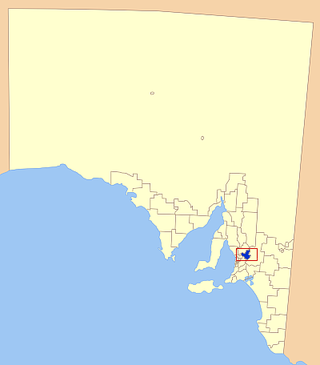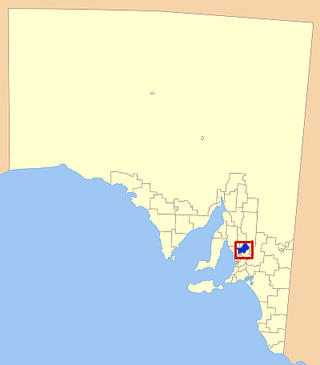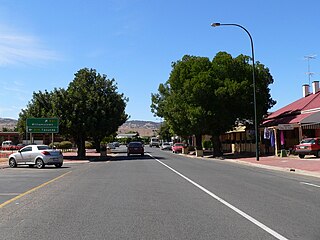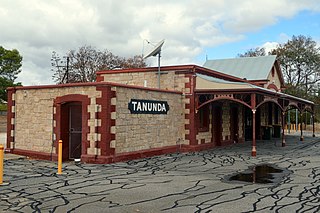
The Barossa Valley is a valley in South Australia located 60 kilometres (37 mi) northeast of Adelaide city centre. The valley is formed by the North Para River. It is notable as a major wine-producing region and tourist destination.

Tanunda is a town situated in the Barossa Valley region of South Australia. In the 2021 census, Tanunda recorded a population of 4,710 people.

Barossa Council is a local government area in the Barossa Valley in South Australia. The council area covers 912 square kilometres, and had a population of over 23,000 in the 2016 Census.

Light Regional Council is a local government area north of Adelaide in South Australia. It is based in the town of Kapunda, and includes the towns of Freeling, Greenock, Hansborough, Hewett, Roseworthy and Wasleys.

Rail transport in the Australian state of South Australia is provided by a number of railway operators who operate over the government-owned railway lines. The network consists of 1435 mm standard gauge links to other states, the 1600 mm broad gauge suburban railways in Adelaide, a freight-only branch from Dry Creek to Port Adelaide and Pelican Point, a narrow-gauge gypsum haulage line on the Eyre Peninsula, and both copper–gold concentrate and coal on the standard-gauge line in the Adelaide–Darwin rail corridor north of Tarcoola.

The Gawler line, also known as the Gawler Central line, is a suburban commuter railway line in the city of Adelaide, South Australia. The Gawler Line is the most frequent and heavily patronised line in the Adelaide rail network. It is also the only line to have no other interchange with another line except Adelaide.

Lyndoch is a town in Barossa Valley, located on the Barossa Valley Highway between Gawler and Tanunda, 58 km northeast of Adelaide. The town has an elevation of 175m and an average rainfall of 560.5mm. It is one of the oldest towns in South Australia.

Angaston is a town on the eastern side of the Barossa Valley in South Australia, 77 km northeast of Adelaide. Its elevation is 347 m, one of the highest points in the valley, and has an average rainfall of 561 mm. Angaston was originally known as German Pass, but was later renamed after the politician, banker and pastoralist George Fife Angas, who settled in the area in the 1850s. Angaston is in the Barossa Council local government area, the state electoral district of Schubert and the federal Division of Barker.

The 2000 class and 2100 class were diesel multiple units that operated on the Adelaide rail network between 1980 and 2015. They were built by Comeng in Granville, New South Wales in 1979–1980. As of 2024, six railcars have been preserved while the rest have been scrapped.

The Barossa Light & Gawler Football Association, more commonly referred to as the BL&GFA, is an Australian rules football competition based in the Barossa Valley, Gawler Region and Light Region of South Australia, Australia. Just 42 kilometres north of the state capital of Adelaide, the BL&GFA is an affiliated member of the South Australian National Football League. In 2024, the Willaston Donnybrooks secured their twenty-fifth premiership overall and their third in the BLGFA. The current president of the League is Mick Brien and the major sponsor of the league is the Grant Burge Winery.

Tanunda railway station is located on the Barossa Valley line. It served the town of Tanunda.

Nuriootpa railway station was located at the junction of the Angaston railway line and the Truro railway line. It served the town of Nuriootpa, South Australia.
The Barossa Trail is a 40 kilometres (25 mi) cycling and walking path through the Barossa Valley in South Australia, opened in May 2014. Much of the Barossa Trail follows the Barossa Valley railway line, but is not a rail trail as part of the railway was still operating at the time it was built. As it is not on the railway formation, it has more undulations than a true rail trail would have. The part near Rowland Flat is away from both the railway and main road. It has much sharper corners than would be expected on a rail trail.
The Leader is a weekly newspaper that was first published in Angaston, South Australia on 24 July 1918, and continues being published to the present day in the Barossa Valley. It was the first English-language newspaper covering any part of the Barossa Valley, apart from the Kapunda Herald.
The 1933 Barossa state by-election was a by-election held on 8 July 1933 for the South Australian House of Assembly seat of Barossa. The by-election was caused by the death on 4 June 1933 of independent MP Dr Herbert Basedow, who had regained the seat at the 1933 election less than two months prior. He had previously held the seat from 1927 to 1930.

The Hundred of Nuriootpa is a cadastral unit of hundred in the County of Light, South Australia split between in the eastern Adelaide Plains and western Barossa Valley. Named in 1847 for an indigenous term officially thought to mean "bartering place" and traditionally used as neutral ground for trading between various indigenous tribes, it is bounded on the south and east by the North Para River.
A by-election was held on 22 November 1924 for one of the seats of the three-member electoral district of Barossa, South Australia. The cause for the by-election was the death of William Hague on 9 October 1924. Despite a field of seven candidates from three parties for three seats at the general election in March, only two candidates stood for the by-election in November. The result was that Henry Crosby for the Liberal Federation with 3732 votes defeated Michael Joseph Murphy for the Labor Party with 3063 votes.

The Tanunda Football Club, nicknamed the Magpies, is an Australian rules football club based in the Barossa Valley town of Tanunda, South Australia, and competes in the Barossa Light & Gawler Football Association.
Stockwell railway station was located on the Barossa Valley railway line. It served the town of Stockwell.












